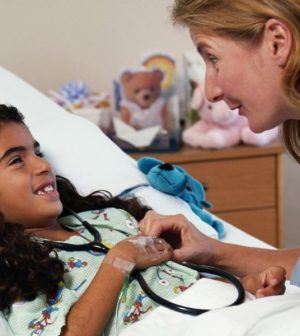- Navigating Your Midlife Crisis: Embracing New Possibilities
- City Raccoons Showing Signs of Domestication
- Mapping the Exposome: Science Broadens Focus to Environmental Disease Triggers
- One Week Less on Social Media Linked to Better Mental Health
- Your Brain Changes in Stages as You Age, Study Finds
- Some Suicide Victims Show No Typical Warning Signs, Study Finds
- ByHeart Formula Faces Lawsuits After Babies Sickened With Botulism
- Switch to Vegan Diet Could Cut Your Greenhouse Gas Emissions in Half
- Regular Bedtime Does Wonders for Blood Pressure
- Dining Alone Could Mean Worse Nutrition for Seniors
Extended Chemo Extends Life for Children With Rare Cancer

Children suffering from rhabdomyosarcoma, a rare cancer of the muscle tissue, may have better chances for a cure if they have extended chemotherapy, a new study finds.
In a phase 3 clinical trial, adding six months of low-dose maintenance chemotherapy after initial treatment extended the five-year survival rate from 74 percent to 87 percent, researchers found.
Children with rhabdomyosarcoma who’ve survived for five years are essentially cured, because the chances that the cancer will recur are very low, the researchers explained.
“We have been treating rhabdomyosarcoma the same way for more than 30 years, and although different approaches have been tried, this is the first randomized trial in rhabdomyosarcoma to show improved outcomes,” said study author Dr. Gianni Bisogno. A professor at the University Hospital of Padova in Italy, he made his remarks in a news release from the American Society of Clinical Oncology (ASCO).
The findings were to be presented Sunday at ASCO’s annual meeting, in Chicago.
Using existing drugs in new ways, Bisogno said, creates a new standard of care, and that can help children and young adults live longer, with less risk of their cancer returning.
Rhabdomyosarcoma starts in the muscles and can occur in any part of the body. It’s most often found in the head, neck, pelvis and abdomen. Rhabdomyosarcoma accounts for 4 percent of all childhood cancers — about 350 children are diagnosed with it each year in the United States.
Most children, 80 percent, can be cured with high-dose chemotherapy, radiation and surgery. In children where the cancer has spread or recurred after initial treatment, however, only 20 to 30 percent can be cured, the researchers said.
For the trial, Bisogno and his colleagues randomly assigned 371 children to either no further treatment after initial therapy or six months of maintenance therapy with low doses of two chemotherapy drugs.
Five-year, disease-free survival was 69 percent for children who only received initial therapy, and 78 percent for those treated with extended chemotherapy.
The most common side effect in those getting extended chemotherapy was low blood cell count, which was usually mild. Incidents of other side effects such as fever were low, and neurologic side effects disappeared after treatment ended. Long-term side effects are still possible, though, and the patients are being followed, the researchers said.
The study authors said findings have changed the standard of care in Europe. But because the standard of care is different in the United States, further study is needed to understand how to integrate maintenance therapy into existing treatments, the researchers said.
“By keeping the pressure on this cancer longer with maintenance therapy, we are giving patients two wins — we are boosting cure rates by preventing relapses and doing so with few serious side effects. After three decades of research, this finding goes to show that we will continue innovating treatment, no matter how long it takes,” Dr. Warren Chow, an ASCO spokesman, said in the news release.
Because the study results were presented at a medical meeting, they should be considered preliminary until published in a peer-reviewed journal.
More information
The American Cancer Society has more on rhabdomyosarcoma.
Source: HealthDay
Copyright © 2025 HealthDay. All rights reserved.










